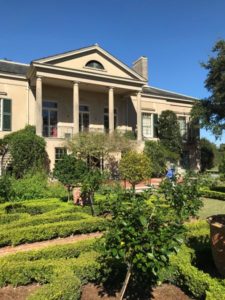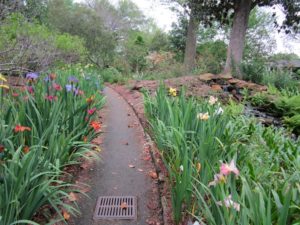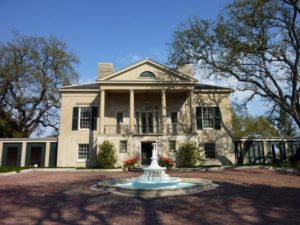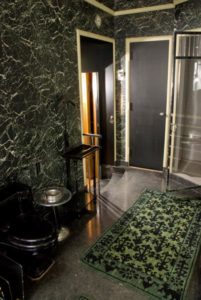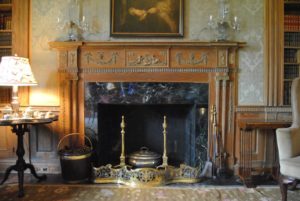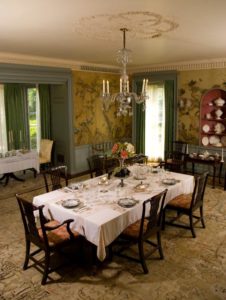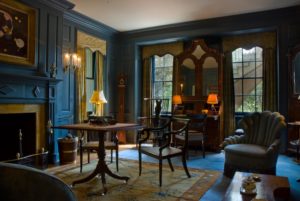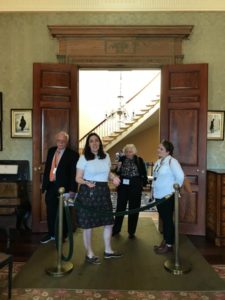Drawn Out to Longue Vue
EVENTS > SYMPOSIA
In Review: The Decorative Arts Trust Fall Symposium, 2018
While the enchanting Creole architecture of the French Quarter and alluring stately beauty of the Garden District are rightly considered among New Orleans’ chief beacons, a suburban 20th-century site offers yet another layer of the city’s renowned cultural history. Longue Vue House & Gardens is an eight-acre oasis adjacent to Metarie. Hemmed in by later development, a golf course, and historic cemeteries, Longue Vue is counted as one of the last great American houses constructed during the Country Place Era.
Longue Vue was built for Edgar and Edith Stern, pillars of the New Orleans community. Edgar was a cotton broker who later diversified his interests to include television and real estate. Edith was the daughter of Julius Rosenwald, the partner of Richard Sears who later took over Sears Roebuck & Co. when Sears retired. The Sterns were active in many civic organizations, with Edith championing the Newcomb College Nursery School, the Voter Registration League, and numerous park and highway beautification projects.
The Sterns purchased the property on the far outskirts of the city in 1921 and built their first home as a newly married couple on the site the following year. The house we encounter today is a later replacement, the product of a partnership between landscape architect Ellen Biddle Shipman (1866–1950), and architects William (1897–1984) and Geoffrey (1909–1985) Platt, whose influences combined to produce an elegant sanctuary. Shipman broke ground on Longue Vue’s gardens in 1935 and continued to shape the landscape until her death in 1950. The Platt brothers took three years (1939–1942) to finish the house.
The project was inspired by the Sterns’ 14-month journey through Europe and Africa in 1936–1937, from which they returned with a desire to replace their existing house with a grand statement that synthesized their ideals of architecture, interiors, and gardens. They were intimately involved in all phases of development. For instance, each of the house’s four facades is different, referencing their fondness for Louisiana architecture and classical influences abroad. The South face pulls from the Beauregard-Keyes House in the French Quarter, whereas the West side suggests the symmetry and structure of the Palladian villas the Sterns encountered in Italy and England.
Shipman’s work on the gardens began in conjunction with the Sterns’ earlier house before expanding to a more ambitious project. She planned the Goldfish Pond and the Pan Garden in 1935. With preparations for Longue Vue underway, the walled garden was constructed in 1938 on the original site of the kitchen garden. Of the many so-called Wild Gardens that Shipman designed for clients, Longue Vue’s is the only one that remains. Planned in 1938–1939, the Wild Garden was intended as a transition away from the formal areas found adjacent to the house. Caroline Dormon, a nationally acclaimed naturalist and conservationist, was a central collaborator for this component. Dormon was particularly influential through her focus on native Louisiana plants. She continued to work on the Wild Garden until her death in 1971.
While Shipman is known primarily for her expertise in developing elegant and artistic gardens and landscapes, Longue Vue represents a rare instance where she oversaw the design of interiors as well, which incorporated the Sterns extensive collection of English and American furniture, Modern and Contemporary art, and English, European, and Chinese ceramics. The Sterns were active on the art and antique market in the early 1930s, and they expressed guilt about the ability to buy at a time when most people were selling. The Sterns collection was largely complete by the time planning for Longue Vue commenced, and Shipman drew inspiration from key objects.
According to Longue Vue Curator Lorna Costa, the Sterns’ collection focused on what they liked and how objects would look with the other items they planned for a particular space. For example, the vintage carpet in the Dining Room was purchased to match the patina of the mid-19th-century hand-painted Chinese wall paintings on rice paper. The Sterns also built a collection of plain creamware, one of the largest outside of England, as it came in a variety of shapes and patterns but lacked the colorful decoration that could distract from the overall decor. They also bought for no reason other than aesthetic appeal and regardless of historic or monetary value. For instance, ceramic birds from Woolworths were displayed in spring to complement a hand-embroidered tablecloth with birds and fruit trees and a setting of either Sevres, Spode, or creamware.
The communication between Shipman’s interior spaces and her garden designs is prominent throughout, creating an exceedingly light and pleasant home that beautifully incorporates the Sterns’ purchases from travels in the United States and abroad. The first-floor Library, clad in 18th-century paneling from a house in Surrey, England, serves as an extension of the landscape, reaching out toward the Upper and Lower Portico Terrace.
Edith continued to live at Longue Vue following Edgard’s death in 1959 but moved to the Pontchartrain Hotel in 1978 to allow the house to become a museum. She died in 1980, the same year that the Longue Vue opened to the public. The interiors are displayed according to their mid-1940s decoration, and guests explore the Sterns’ primary entertaining rooms as well as functional spaces. From the rooms dedicated to gift wrapping and flower arranging to Edgar Stern’s splendid Art Deco bathroom, we experience the full breadth of operations at Longue Vue.
If you were unable to join us in New Orleans this fall, we encourage you to break free of the French Quarter’s grasp
during your next visit to enjoy Longue Vue House & Gardens (longvue.com). The collaboration of the Sterns, Shipman, and the Platts resulted in a stunning site worthy of your admiration.
All images are courtesy of Longue Vue House and Gardens.

